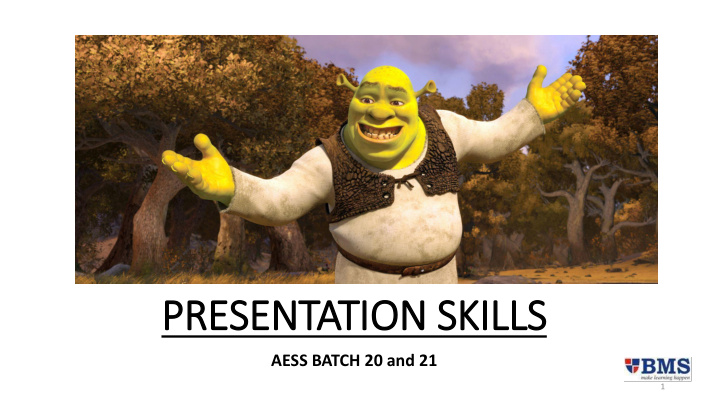



PRESENTATION SKILLS AESS BATCH 20 and 21 1
Contents (Reference: University of Leicester) 1. Preparation 2. Points/Arguments 3. Supporting Information 4. Responding to questions 5. Using PowerPoint 6. Important points that enhance presentation skills 2
Preparation Objectives: • What do you want your audience to understand? • What action do you want your audience to take following your presentation? • How can you best design your presentation to meet your objectives? Audience: • How much will your audience already know about your topic? • How can you link new material to things they might already understand? • Will you need to win them over to a particular point of view? 3
Venue: • What kind of atmosphere do you wish to create? • How might the room arrangement affect your relationship with the audience? • Can you do anything to change the arrangement? • What audio-visual aid can you use? Guidelines: • How much time have you been allocated? • Are you required to stick to a common format or style? • Have any guidelines been set regarding the content of your presentation? 4
2. Points/Arguments • The main and sub points/arguments are the most important parts of the presentation • These points/arguments help in structuring, prioritising examples, facts and statistics • Use visual aid (diagrams/charts) • Use supporting information to enhance the effectiveness and interest -Explain complex terms and providing examples or statistics -Quote experts and offering evidence from your own research -Show a video clip • Do not provide too much of information 5
3. Transitions and Conclusion • A smooth flow using transitional words and phrases • Transitions will also help in signposting, which directs the audience through the presentation “Another important issue of consideration was …” “ By following this argument we can now see that …” • Conclude with a summary of the key and sub points and a review of the objectives • Use a parting statement which might be a question or a comment 6
4. 4. Responding to questions • Inform your audience when questions will be allowed and manage the allotted time • Prepare prompts for questions that are open and straightforward: “That’s the end of my presentation. I’d now like to take questions from the audience ” • Listen to all the parts of the question and understand • Respond and direct your answer to both the questioner and the audience • Allow follow-up questions • Avoid defensive answers and passing the blame 7
5. 5. Usin ing PowerPoint Design: • Be consistent (template/design/font) • Use an appropriate text colour as it can be difficult to read • Avoid too much of text and use bullet points (six-by-six rule) • Font size should be at least 24pt and text should be left aligned • Set clear hierarchies for font size to identify headings, main text and others • Use bold for emphasis and headings rather than UPPER CASE, italics 8
Graphics: • Try not to use Clip Art • Choose an appropriate quality for scanned images • Images that you take from the internet should be cited properly • Make sure graphics are relevant to your text and not just decorative • Consider using graphics for easier understanding 9
Animations and transitions: • Make sure that any animation you use serves a clear purpose -To introduce a new piece of information at an appropriate point -To show progression • Maintain consistency • Do not overuse animations and transitions 10
Preparing to present: • Will the audience be able to see the slides from the back of the room? • Does anyone of my audience have special requirements? • Have I rehearsed my presentation? • Have I checked that the necessary equipment? • Do I have an alternative plan in case the technology fails? 11
Presenting: • Treat each slide as a mini-presentation -Introduce the idea, give details and then conclude -Explain how the point fits in with the rest of your presentation • Direct your audience’s attention to the slides when they contain key information • Give your audience time to assimilate material on your slides • Do not move your pointer on the screen unless you are using it for demonstrations • Do not just read out the text on the slides 12
USE KEYBOARD SHORTCUTS WHENEVER POSSIBLE 13
6. . Im Important points that enhance presentation skil ills • The presentation should run according to the time allotted • Speaker notes or cue cards must be prepared beforehand • Speaker notes must be numbered • Points which need emphasis must be annotated in the speaker notes • PowerPoint slides or any visual aid needed must be prepared beforehand 14
• Facts/citations/references/grammar/spellings must be checked • The contents of the presentation must be well structured • Practise – familiarise with the content of the presentation • Apt posture, habits and presence; wear appropriate clothing(formal/semi-formal) • Make contact with the audience - eye contact, gestures, language • Use your voice suitably – volume, pace and breathing pauses, pitch 15
16
Recommend
More recommend